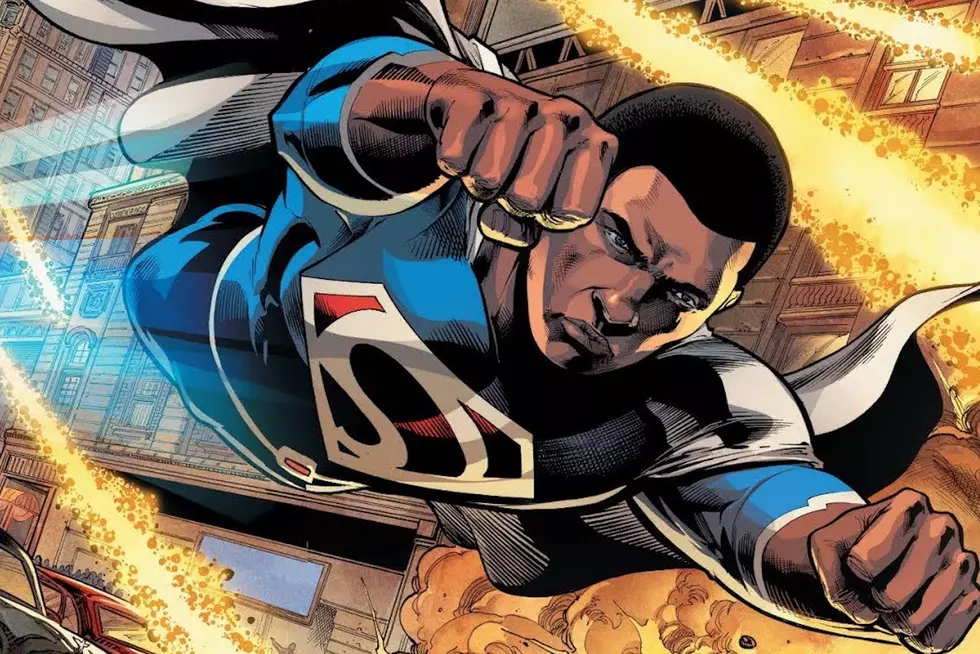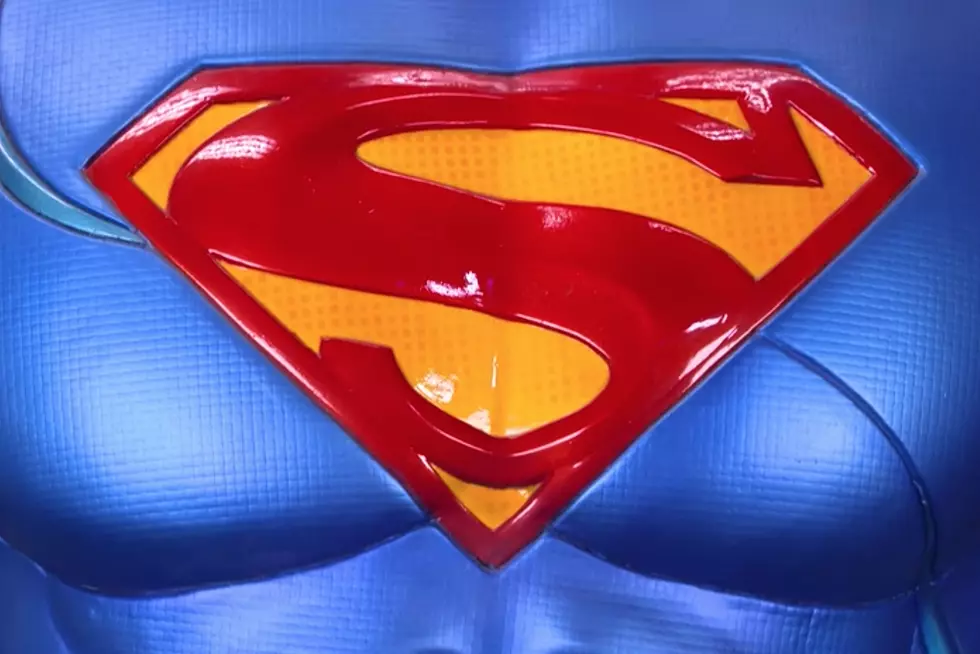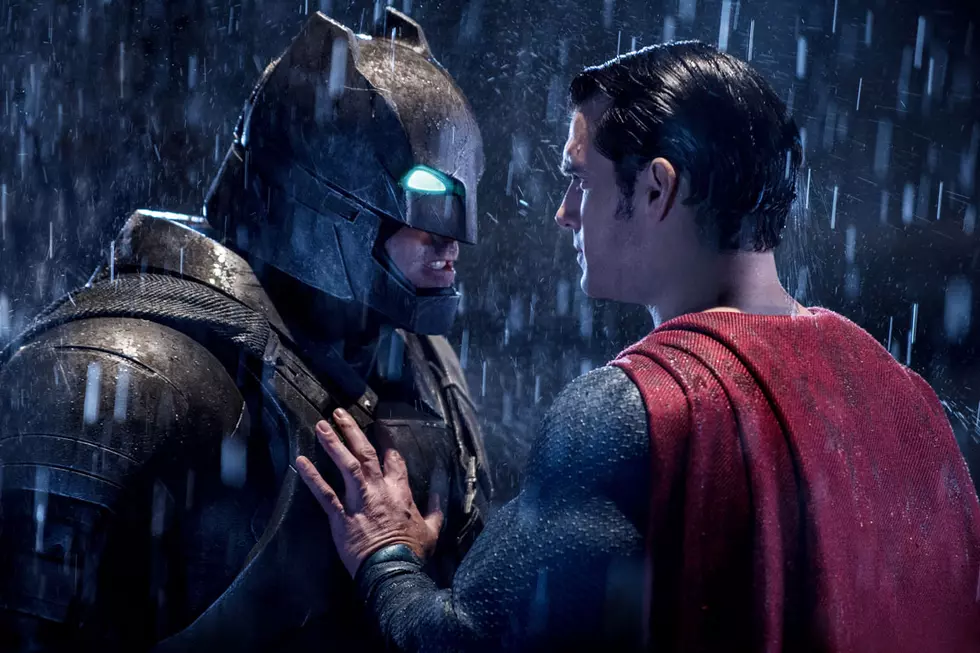
Ask Chris #171: The Superman (Well, Supermen) of the Marvel Universe
Q: Do Superman-esque characters like The Sentry or Blue Marvel work in the Marvel Universe? -- @SuperSeth64
A: You know, Seth, this is one of those questions that seems really simple when you first look at it. I mean, it's a yes or no question, so the short answer is about as short as it can possibly be. The thing is, the reasoning behind that answer has to do with how entire shared fictional universes work and how they've been influencing each other for the past 50 to 70 years, and how one character in particular has defined an entire genre that came to dominate the medium, so for the long answer, well, I hope you've got a few minutes.
If you don't, here's the short answer: No. No they do not.
Which isn't to say they haven't tried, of course, and to be honest, it's not even to say that the characters that are based on that aren't any good. Gladiator, for instance, is about as transparent a Superman knockoff as he can be -- you know, the super-powered alien in a red and blue costume with a cape named "Kallark" whose codename is a reference to the Philip Wylie novel that heavily influenced Siegel and Shuster? -- and he's one of those great little Marvel Universe supporting characters that can be dropped into the background of almost any story to give it a touch of the strange or cosmic. Then there's Hyperion from Squadron Supreme, who's part of a whole team of Justice League analogues and who was at the center of a series that was equal parts deconstruction and genuine superhero epic before that was cool. The good one by Mark Gruenwald and Bob Hall, I mean, not the terrible later version written by Michael "Just can't stop writing Alan Moore fanfic" Straczynski.
Those are both good characters that are in good stories, but they don't really work all that great outside of their specific contexts. Gladiator is awesome when he shows up to smack around the X-Men or lead the charge against some cosmic threat, but he's never going to hold down a series where he coexists with the rest of the Marvel universe for any great length of time. Squadron Supreme is every bit as amazing as the books that always overshadow it, but the same goes for Hyperion. They have their defined roles, and with the way that universe was built, they're very difficult to break out.
What it comes down to is that the Marvel universe is built on limitations. That's the core difference between the foundation of the Marvel Universe and the DC Universe. Even though they've largely been shaped by the same creators over the past few decades, they're built around very different ideas that are expressed in the characters that define them. There's nothing that makes me roll my eyes harder than when people refer to the DC characters as "Gods" because that's such a goofy, high school way to look at them, but even I'll admit that there's an element of truth to it. The DC Universe, even before there was a DC Universe, was built around characters that have this uncomplicated aspirational ideal to them. You just need to look at Superman to see it.
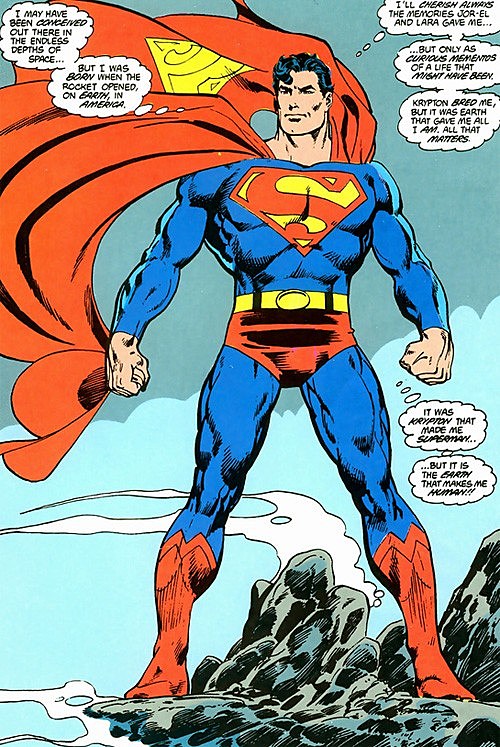
Despite what you may have heard, Superman is not a complicated character. He's an extremely simple idea: A man with the power to do anything who always does the right thing. That's it. He is, quite simply, the best and most powerful person in the world, and that kind of simple idea is at the core of those characters right on down the line: Batman isn't an accomplished vigilante, he's The World's Greatest Detective. The Flash is The Fastest Man Alive. Green Lantern has The Most Powerful Weapon In The Universe. Captain Marvel is the World's Mightiest Mortal, and while he might not have been a DC character originally, there was enough of him that got filtered down to Superman (via Otto Binder, who would become the most important Superman writer of the Silver Age) that the idea behind it counts as much as anything does. These are ideas that are limited only by the imagination and the occasional storyline McGuffin designed to create a little tension before Good ultimately wins out (more on those in a minute).
The result is that the universe that springs up around these characters has that same idea of limitlessness to it. There's no ceiling on how big and exaggerated things can get in the DC Universe, which is why Gotham City's had 75 years of the World's Greatest Detective and is still a horrifying red-skied crime-ridden nightmare. It has to be because that's the challenge that you have to give a character like that. It wasn't too long ago that I was complaining about how Superman hasn't done anything for the past 20 years other than fight Zod, Doomsday and Darkseid, and while I think that's a huge part of The Problem, it's easy to see why they keep going back to those same three villains: The evil version of Superman himself, the unstoppable physical force, and a tyrannical Cosmic God of Evil. Those are big problems, and when you have a character defined by being Best and Most Powerful, I imagine it's hard to figure out something else that's suitable.
On the flipside, we have the Marvel Universe, which was created as a direct contrast to those limitless characters. If you go back and read those early Marvel comics, it's amazing to see how much they were trying to distinguish themselves from the characters that were dominating the market, and not just because Stan Lee was taking smarmy pot-shots at Brand Ecch in the letter columns. These were stories that were assembled out of monster comics, romance books and horror stories, and those were all about imposing limitations on characters. Here was a monster who couldn't be stopped, here was the plaintive yearning that could never be fulfilled, here was the one mistake that doomed us, doomed us all. Those were the elements Timely had been batting around for years -- Marvel's big trick was just applying those same beats to adventure stories.
I've written about Lee and Steve Ditko's Amazing Fantasy #15 before, and how weird it is if you try to look at it in isolation. If you don't know that Spider-Man comes back and goes on to become one of the most successful, long-running characters of all time, it reads like a horror comic, to the point where it ends with a boy walking down a dark street crying because he's responsible for his father figure's death. In a lot of ways, Lee and Jack Kirby's Fantastic Four #1 is the same way. One man's hubris leads him to drag his family into the dark unknown of space, and they end up getting these "powers" that are kind of visually horrifying -- one of them becomes an actual monster.
The result of that is that you get a universe that's built around these little tragedies, and part of that involves putting limits on those characters, even if you're just putting them there to see them overcome. Go down the list of Marvel characters, and they all have these limits on what they can do. Daredevil's really just a guy who's pretty good at fighting even though he can't see. Iron Man wears a tank, but he's got that heart problem. Captain America's the best human being you can imagine, but he still needs to catch bullets on that shield instead of bouncing them off of his chest. The closest you get to the kind of definitive superlative that you have with the DC Characters among those early Marvel guys is the Hulk, and folks, that dude has problems like you would not believe.
The two best examples are, naturally, the character who was the prototype for this formula and the one that defined it: The Thing and Spider-Man. The Thing's pretty self-explanatory (sad rock monster), but Spider-Man embodies this idea more than anyone else in the company. Spider-Man's strong -- listen, bud, he's got radioactive blood -- and when you think about how much of an effort it would be to lift up a car with your bare hands, you start to understand that he's really strong. But he's not so strong that he can just lift up anything.
Until he can, that is.
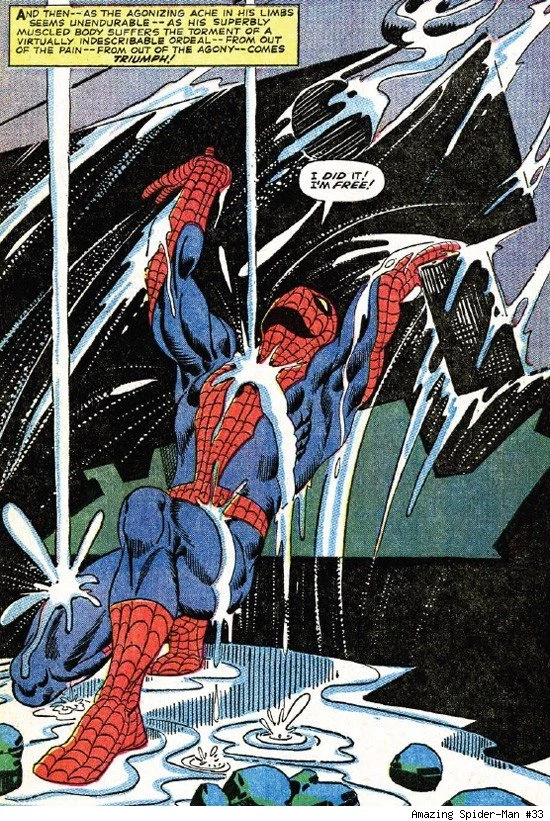
That's the entire trick with the Marvel characters, isn't it? They spend all their time telling you what they can't do, and then they do it, and we're all impressed because we've been told so often about those limitations. It's not impressive for Superman to lift up a bunch of wreckage because all they do is tell us how strong he is, but when Spider-Man does it, it's almost unbelievable that he pulled it off, even though all of this stuff is every bit as made up as the rest of it.
That's the contrast between the universes, and to be honest, neither approach is intrinsically better than the other. They've each produced fantastic and terrible stories over the years, and they each have characters that are some of the best in fiction and also Aquaman and Cyclops. They're just different, and that's part of how they're designed, and there are also bits and pieces of each universe that run against the grain.
Incidentally, these ideas of limitations and the lack thereof are all carefully maintained lies that collapse the moment you actually think about them. Superman's got a weakness so on-the-nose that "Kryptonite" has become a synonym for the word "weakness," and there are a thousand dei ex machina to get any Marvel character past any obstacle they might face, too. Part of maturing as a reader is realizing that all of this is constructed in service of a story that's being told, and another part is realizing that even when you know they're constructed, you've got to buy into all these ideas being valid anyway. The reason Spider-Man doesn't wear an Iron Man suit that makes him bulletproof and gives him jet boots is that a bulletproof Spider-Man isn't as exciting to read about, something that they actually went out of their way to prove as fact a couple years ago.
At this point, you may be wondering when I'm actually going to get back to the part of the column where I actually answer your question, and we're getting close. I have to confess, though, that I'm almost completely unfamiliar with the Blue Marvel, although a quick look at his Wikipedia page includes the phrase "After a surprise confrontation with Sims on the moon," so believe me, I'm interested. We're almost there, trust me, but I had to go through all that because when you're talking about Marvel's roster of Superman knockoffs, you're really talking about taking the core idea of one universe and putting it into another.
It's worth noting that when the DC Universe tries to adopt ideas from Marvel, it tends to go pretty well, up to a point. It's easy to think that's because Marvel was built around newer, more forward-thinking ideas, and to be honest, that's partly true. But it's also true that since 1961, DC has wanted nothing more than to be more like Marvel Comics, and they've reshuffled their entire approach to their universe accordingly. This has led to some great stuff, too -- another thing I've written about before is that Wally West, the character who more or less defined the '90s for DC Comics, was really just DC's version of Spider-Man -- but it's also a huge part of The Problem, and that's a discussion for another time.
When it's Marvel attempting to incorporate a DC style idea, there's a lot more friction, and there's no place that shows that more clearly than when they try to do a "Marvel-style" take on Superman. They're bringing Superman into a universe that was created to be a contrast to Superman, so every time they do it, they have to hammer it into a shape that fits. Gladiator has the powers and the names, but he's a space conqueror who's literally powered by his ego. Hyperion is just as much of a flawed clone as Bizarro.
And then you've got the Sentry, who shows the problem and the solution better than anyone.
Back when I was working at the shop, we had a book discussion club, and one of the most memorable sessions was when we picked that original Paul Jenkins/Jae Lee Sentry miniseries to talk about. About a dozen of us all got together after we'd read (or re-read) it, and while we all started out kind of agreeing that we liked it and that it was an interesting experiment in showing the contrasts between universes, the more we picked apart the idea of creating a Superman-type character, giving him those traditional Marvel limitations and then trying to retrofit him into the Marvel universe, the more we hated it. Over the course of about three hours, the whole group, who I don't think had ever 100% agreed on anything before, had pulled a full 180 on The Sentry and were laughing about how much we hated it.
The short version (ha!) is that it just didn't work. It collapsed as soon as you poked at it, it was too disjointed, it required you to make too much of a leap to believing that universe could ever have been built the way it is if that character had really been there all along. And to be fair, maybe the problem wasn't with the character himself (although I'd argue that the Sentry was barely a character at all), but with that original publicity stunt gimmick of trying to make him a "lost" character who'd been there all along. He doesn't fit.
And then like two months later he showed up in The Avengers, so, you know, whatever.
For a long time, I just flat-out hated the Sentry as a concept, because he only came close to working in that original mini-series, and didn't even work well there. Having him lingering around in the actual Marvel Universe was just seeing this weird floppy appendage that didn't do much of anything but rip Carnage in half for the benefit of people who would be impressed by ripping Carnage in half. If you're one of them, I'm sure you're lovely, but I don't think we have a whole lot of common interests. But then something happened that made me completely reconsider:
Age of the Sentry, by Jeff Parker, Paul Tobin, Nick Dragotta and Colleen Coover. As you can tell from the cover, I love this thing.
A big part of that is that it's basically just Parker and Tobin writing Silver Age Superman fan-fiction with all the goofy stuff I love about those comics, like Ursas the Ultra-Bear and Harrison Oogar, the Caveman of Wall Street, but the story actually ran a little deeper than that, and it solved the problem of how to make him work very neatly. Instead of taking the character and altering him to fit the universe, they altered the universe around the character. Age of the Sentry created a "lost," "Silver Age-style" version of the Marvel Universe where a character like the Sentry could exist, and that made all the difference.
Now, obviously, that's pretty easy to do on a small scale when you're dealing with an isolated miniseries and a whole lot harder to do when you're working with an entire fifty year-old shared universe, but it's really the only way. Otherwise, you just end up hammering things to fit, and more often than not, that hammering makes them break.
More From ComicsAlliance



